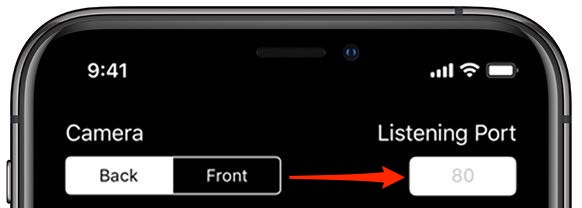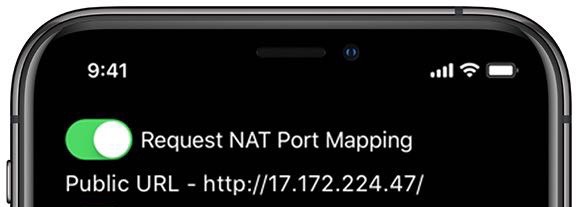Features
- Stream images, video & audio to compatible applications including most web browsers and our iCamSource and iCamSource Pro apps.
- Select either the front or back camera.
- Turn the Flash on and off via the Web Interface.
- Adjust the image size, quality, and frame rate.
- Auto-rotate the image based on device orientation.
- Optional Date / Time image overlay.
- Optional 4:3 aspect ratio image crop.
- Digital Pan / Tilt the 4:3 cropped image.
- Optional Login & Password for additional security.
- Tap video preview to toggle darkened screen.
- Dynamic DNS support for DynDNS and No-IP users.
- Automatic Port Forwarding for routers that support UPnP or NAT-PMP.
Options
- Camera - Choose either the Back or Front camera as the input image / video input.
- Image Size - Supported image sizes are Small, Medium, and Large. Actual image sizes vary depending on the specific iOS device. Larger image sizes can result in slower video frame rates.
- Image Quality - Set the JPEG image compression quality from Low to High. Higher image qualities can result in slower video frame rates.
- Frame Rate - Set the maximum frame rate for the MJPEG video streams.
- 4:3 Crop - If the camera image is taller than its width (or if the image aspect ratio is widescreen 16:9) then the image will be cropped into a standard webcam 4:3 aspect ratio. The position of the crop can be adjusted either via the Web Interface's Pan / Tilt links or by swiping the preview image up & down or right & left.
- Timestamp - Add a date / time overlay to the output image.
- Listening Port - Change the port that ipCam will listen on. (The default is HTTP port 80.)
- Security - Require a login and password to connect to ipCam from your web browser, iCamSource, etc.
- Audio - Enable the capturing and streaming of audio.
Advanced Options
ipCam's advanced options are meant to make it easier for users to access ipCam from outside of their local network.
- Request NAT Port Mapping - If your network router supports UPnP or NAT-PMP then ipCam may be able to automatically forward the appropriate TCP port to the iOS device running ipCam. Use the Public URL to connect to your device running ipCam from outside of your local network.
- Dynamic DNS Update - If you have a DynDNS or No-IP account ipCam can automatically update your dynamic IP hostname.
Web Interface
Once ipCam is running, you can connect to its Web Interface from most any modern web browser that is also connected to your local network by entering the http://xxx.xxx.xxx.xxx/ URL located at the bottom of the Preview screen:

The Web Interface gives you access to various image, video, and audio links in addition to the links that control the Flash and Pan / Tilt functionalities, when available.
Web Browser Links
- JPEG Video - Compatible with all web browsers tested. Includes Flash and Pan / Tilt commands, when available.
- MJPEG Video + HTML 5 PCM Audio - Not compatible with Internet Explorer. Audio is only compatible with latest versions of Chrome and Firefox.
Raw Audio / Video Links
- JPEG Image - Single JPEG image.
- MJPEG Video - MJPEG video stream. This is the optimal URL to use with the iCamSource.
- WAV Audio - WAV audio stream.
- Raw PCM Audio - Raw PCM audio stream.
Flash Links
- Turn Flash On | Off - Allows you to turn the iPhone Flash On and Off when the Back camera is selected.
Pan / Tilt Links
Pan / Tilt functionality is only enabled when the 4:3 Crop option is enabled and the raw camera image is not already a 4:3 aspect ratio.
- Pan Left | Right - When the iOS device is on its side (Landscape) and the image has been 4:3 cropped, Panning Left and Right moves the crop in the appropriate direction to allow you to select which portion of the image to view.
- Tilt Up | Down - When the iOS device is standing upright (Portrait) and the image has been 4:3 cropped, Tilting Up and Down moves the crop in the appropriate direction to allow you to select which portion of the image to view.
Frequently Asked Questions
How do I connect to ipCam from outside of my local WiFi network?
If you are familiar with iCam or iCam Pro you may be used to being able to connect from outside of your local network without any additional configuration due to iCam's zero-config connection logic that uses our iCam Broker Server to coordinate the connection between iCam and the iCamSource. iCam uses a proprietary protocol that was built with this functionality in mind.
ipCam, on the other hand, effectively turns your iOS device into a network IP camera that uses the standard web protocol to communicate. Just like with any other IP camera, you will need to configure your network router to forward a single TCP port to your iOS device's internal IP address. (Your iOS device's internal IP address is listed at the bottom of the Preview screen in ipCam.)
Important Side Note: If you are attempting to connect from outside of your local network, some ISPs do block incoming connections on the default web listening port (80) to discourage users from running web servers on their home networks. The solution in that case is to configure the Listening Port of ipCam to be something else (81, 8080, 12345, etc.) in the Options screen:

If you are unfamiliar with forwarding ports in your router and your router supports UPnP or NAT-PMP (and it is enabled) you can try turning on Request NAT Port Mapping in the Advanced options screen:

If the Automatic Port Forwarding is successful you should be able to type in the Public URL into a web browser from outside of your local network and connect. For Example: If your external IP address is 17.172.224.27 and your listening port is 81, you are going to want to enter http://17.172.224.27:81 into your web browser to connect from outside of your local network.
How do I connect to ipCam using iCam and the iCamSource?
Since ipCam essentially turns your iOS device into a WiFi network IP camera you will want to add it to your iCamSource under the Ethernet / Wi-Fi tab. The MJPEG URL that you will want to use is http://xxx.xxx.xxx.xxx/video.mjpg where xxx.xxx.xxx.xxx is the local IP address that you use to connect to ipCam's web interface using your web browser.
